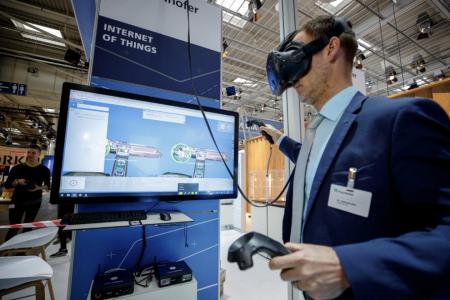Industrial Internet Of Things can push Asean forward
Technological wave can build new revenue streams while reducing workload
As China's growth slows, the world is watching Asean countries gain a greater share of the global economy.
But many say that one obstacle between Asean and its new economic scale is the increasing scarcity of available talent in the region, simply due to the fact that business growth in this region is outpacing talent availability.
Moreover, a wave of technological advancement dubbed the Industrial Internet of Things (Industrial IoT) has knocked on the doors of this manufacturing hub, bringing not only smart and connected digital assets into the once labour-intensive industrial plants but also new solutions to narrowing South-east Asia's talent gap.
TOWARDS HIGHER PRODUCTIVITY
While governments are embracing the current wave of industrial revolution, businesses grapple with how they can monetise Industrial IoT with current market realities in local skill sets.
From electronics to garment factories, Asean countries have taken on the low-cost and low-level manufacturing jobs from China, the erstwhile world's factory.
Labour costs may be lower compared to China, but the output per worker is also weaker.
According to consulting firm McKinsey & Co, the average labour productivity in Vietnam's manufacturing sector was only about 7 per cent of that in China in 2012.
The latent opportunity for Asean markets lies with companies embracing Industrial IoT to help them transform from a low-cost and low-output economic model into a highly productive and profitable one.
What businesses in this part of the world need to realise is that growth in profit margins works in tandem with an increase in human productivity and vice versa.
New technologies such as Big Data and IoT, for instance, could help build new service revenue streams while reducing unnecessary workload where possible - by including digitised options for ordering manuals and spare parts; and putting in place models to monetise the knowledge, advice and best practices of their own employees for greater efficiency across the entire value chain.
TRAINING A FUTURE-READY WORKFORCE
Even with the apparent benefits of boosting productivity and profit growth, many companies in South-east Asia still contend with a workforce that is not yet trained to fully adapt and reap the potential brought about by Industrial IoT. Skill gaps appear to be an increasingly important barrier.
To address this challenge, stakeholders, including individuals, employees, technology providers and training institutions, need to collaborate with industries and businesses to ensure the correct training and experiential learning is provided to optimise the benefits Industrial IoT brings.
This requires all relevant parties to implement an effective training strategy to ensure the best outcomes.
For manufacturing companies, building a sustainable learning environment while adapting a human-centric approach that takes into account the differences in employees' education, experience and skill sets could strengthen the learning and innovative capacity of both the individuals and the businesses.
There are also existing training resources that companies can tap to help improve their employees' exposure to Industrial IoT.
Schneider Electric's Energy University, for instance, offers courses ranging from energy utilisation and reduction, to production process optimisation.
Launched in 2009, Energy University has almost 600,000 registered users, with nearly one million courses completed globally to date.
In fact, Indonesia is among the top five countries taking advantage of such complimentary online training.
Meanwhile, other key industry stakeholders, academic institutions and customers could also be engaged in training to ensure the staff are equipped to take on the challenges of tomorrow.
WINNING THE RIGHT TALENT
The pursuit of good talent and high productivity will last as long as the economy continues to thrive.
Although Asean is currently taking over the final assembly lines from China, there is hope that Industrial IoT could help the dynamic region leapfrog towards high value-added industries.
With Asean poised to be the world's next economic common market after the European Union, the workforce in the region must stay competitive to drive full market integration and industrial upgrading powered by Industrial IoT.
This requires all members of the Asean community from both the public and industrial sectors to collaborate towards a winning talent and workforce development strategy for the era of digital industrialisation.
The writer is president, East Asia and Japan at Schneider Electric. This article appeared in The Business Times yesterday.
Get The New Paper on your phone with the free TNP app. Download from the Apple App Store or Google Play Store now



